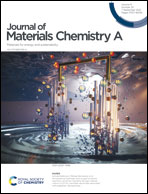Efficient electrocatalytic conversion of CO2 to syngas for the Fischer–Tropsch process using a partially reduced Cu3P nanowire†
Abstract
Electrochemical conversion of CO2 into syngas (CO and H2) has attracted extensive research studies because it is a promising pathway to produce liquid fuels and industrial chemicals. However, to achieve a high current density at a desired CO/H2 ratio is still a great challenge although it is extremely important in practical applications. In this work, we developed a partially reduced Cu3P nanowire (R-Cu3P/Cu) by selective phosphating to catalyze the CO2-to-syngas conversion. It is found that R-Cu3P/Cu is highly effective for the conversion with a wide tunable range of the CO/H2 ratio (0.1–2.24) and high faradaic efficiency (FE, >93%). More importantly, this catalyst exhibits a record current density of 115 and 82.9 mA cm−2 at the CO/H2 ratio of 2/5 and 1/2, which are precisely required for Fischer–Tropsch synthesis. Mechanism studies reveal that the effective charge transfer from Cu to P on the partial phosphorus vacancy surface makes Cu3P nanostructures exhibit remarkable activity and selectivity for CO2 reduction by a diatomic activating bimolecular mechanism.



 Please wait while we load your content...
Please wait while we load your content...